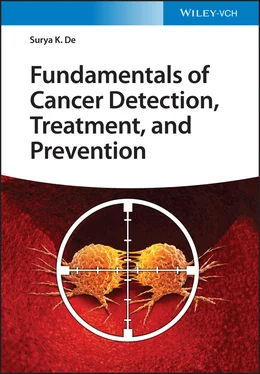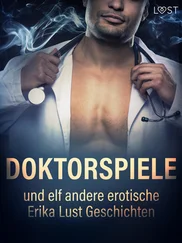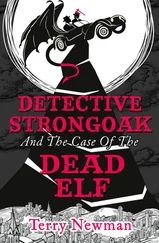Surya K. De - Fundamentals of Cancer Detection, Treatment, and Prevention
Здесь есть возможность читать онлайн «Surya K. De - Fundamentals of Cancer Detection, Treatment, and Prevention» — ознакомительный отрывок электронной книги совершенно бесплатно, а после прочтения отрывка купить полную версию. В некоторых случаях можно слушать аудио, скачать через торрент в формате fb2 и присутствует краткое содержание. Жанр: unrecognised, на английском языке. Описание произведения, (предисловие) а так же отзывы посетителей доступны на портале библиотеки ЛибКат.
- Название:Fundamentals of Cancer Detection, Treatment, and Prevention
- Автор:
- Жанр:
- Год:неизвестен
- ISBN:нет данных
- Рейтинг книги:4 / 5. Голосов: 1
-
Избранное:Добавить в избранное
- Отзывы:
-
Ваша оценка:
- 80
- 1
- 2
- 3
- 4
- 5
Fundamentals of Cancer Detection, Treatment, and Prevention: краткое содержание, описание и аннотация
Предлагаем к чтению аннотацию, описание, краткое содержание или предисловие (зависит от того, что написал сам автор книги «Fundamentals of Cancer Detection, Treatment, and Prevention»). Если вы не нашли необходимую информацию о книге — напишите в комментариях, мы постараемся отыскать её.
The professional guide to cancer diagnosis and therapy for researchers and clinicians Fundamentals of Cancer Detection, Treatment, and Prevention,
Fundamentals of Cancer Detection, Treatment, and Prevention
Fundamentals of Cancer Detection, Treatment, and Prevention — читать онлайн ознакомительный отрывок
Ниже представлен текст книги, разбитый по страницам. Система сохранения места последней прочитанной страницы, позволяет с удобством читать онлайн бесплатно книгу «Fundamentals of Cancer Detection, Treatment, and Prevention», без необходимости каждый раз заново искать на чём Вы остановились. Поставьте закладку, и сможете в любой момент перейти на страницу, на которой закончили чтение.
Интервал:
Закладка:
56 56 Nash, S.H., Liao, L.M., Harris, T.B., and Freedman, N.D. (2017). Cigarette smoking and mortality in adults aged 70 years and older: results from the NIH‐AARP cohort. American Journal of Preventive Medicine 52 (3): 276–283.
57 57 Hecht, S.S. (2003). Tobacco carcinogens, their biomarkers and tobacco‐induced cancer. Nature Reviews Cancer 3 (10): 733–744.
58 58 Austoni, E., Mirone, V., Parazzini, F. et al. (2005). Smoking as a risk factor for erectile dysfunction: data from the andrology prevention weeks 2001–2002. A study of the Italian Society of Andrology (S.I.A.). European Urology 48 (5): 810–818.
59 59 Hatsukami, D.K., Stead, L.F., and Gupta, P.C. (2008). Tobacco addiction. Lancet 371 (9629): 2027–2038.
60 60 Piano, M.R., Benowitz, N.L., Fitzgerald, G.A. et al. (2010). Impact of smokeless tobacco products on cardiovascular disease: implications for policy, prevention, and treatment: a policy statement from the American Heart Association. Circulation 122 (15): 1520–1544.
61 61 Villanti, A.C., Richardson, A., Vallone, D.M., and Rath, J.M. (2013). Flavored tobacco product use among U.S. young adults. American Journal of Preventive Medicine 44 (4): 388–391.
62 62 Walter, V., Jansen, L., Hoffmeister, M., and Brenner, H. (2014). Smoking and survival of colorectal cancer patients: systematic review and meta‐analysis. Annals of Oncology 25 (8): 1517–1525.
63 63 Warren, G.W., Kasza, K.A., Reid, M.E. et al. (2013). Smoking at diagnosis and survival in cancer patients. International Journal of Cancer 132 (2): 401–410.
64 64 Parsons, A., Daley, A., Begh, R., and Aveyard, P. (2010). Influence of smoking cessation after diagnosis of early stage lung cancer on prognosis: systematic review of observational studies with meta‐analysis. British Medical Journal 340: b5569.
65 65 Travis, L.B., Rabkin, C.S., Brown, L.M. et al. (2006). Cancer survivorship – genetic susceptibility and second primary cancers: research strategies and recommendations. Journal of the National Cancer Institute 98 (1): 15–25.
66 66 Peto, R., Darby, S., Deo, H. et al. (2000). Smoking, smoking cessation, and lung cancer in the U.K. since 1950: combination of national statistics with two case‐control studies. British Medical Journal 321 (7257): 323–329.
67 67 Inoue‐Choi, M., Hartge, P., Liao, L.M. et al. (2018). Association between long‐term low‐intensity cigarette smoking and incidence of smoking‐related cancer in the National Institutes of Health‐AARP cohort. International Journal of Cancer 142 (2): 271–280.
68 68 Prignot, J.J., Sasco, A.J., Poulet, E. et al. (2008). Alternative forms of tobacco use. The International Journal of Tuberculosis and Lung Disease 12 (7): 718–727.
69 69 Smith‐Simone, S., Maziak, W., Ward, K.D., and Eissenberg, T. (2008). Waterpipe tobacco smoking: knowledge, attitudes, beliefs, and behavior in two U.S. samples. Nicotine & Tobacco Research 10 (2): 393–398.
70 70 Corey, C.G., Ambrose, B.K., Apelberg, B.J., and King, B.A. (2014). Flavored tobacco product use among middle and high school students‐‐United States. MMWR Morbidity and Mortality Weekly Report 2015 64 (38): 1066–1070.
71 71 Henley, S.J., Thun, M.J., Chao, A., and Calle, E.E. (2004). Association between exclusive pipe smoking and mortality from cancer and other diseases. Journal of the National Cancer Institute 96 (11): 853–861.
72 72 Wyss, A., Hashibe, M., Chuang, S.C. et al. (2013). Cigarette, cigar, and pipe smoking and the risk of head and neck cancers: pooled analysis in the International Head and Neck Cancer Epidemiology Consortium. American Journal of Epidemiology 178 (5): 679–690.
73 73 Fontham, E.T.H., Wolf, A.M.D., Church, T.R. et al. (2020). Cervical cancer screening for individuals at average risk: 2020 guideline update from the American Cancer Society. CA: A Cancer Journal for Clinicians 70 (5): 321–346.
74 74 Leyden, W.A., Manos, M.M., Geiger, A.M. et al. (2005). Cervical cancer in women with comprehensive health care access: attributable factors in the screening process. Journal of the National Cancer Institute 97 (9): 675–683.
75 75 Saslow, D., Andrews, K.S., Manassaram‐Baptiste, D. et al. (2020). Human papillomavirus vaccination 2020 guideline update: American Cancer Society guideline adaptation. CA: A Cancer Journal for Clinicians 70 (4): 274–280. https://doi.org/10.3322/caac.21616. Epub 8 July 2020. PMID: 32639044.
76 76 Berger, A.H. and Pandolfi, P.P. (2011). Cancer susceptibility syndromes. In: DeVita, Hellman, and Rosenberg's Cancer: Principles and Practice of Oncology, 8e (ed. V.T. DeVita, T.S. Lawrence and S.A. Rosenberg), 161–172. Philadelphia, PA: Lippincott Williams & Wilkins, a Part of Wolters Kluwer Health Adis (ESP).
77 77 Boniol, M., Autier, P., Boyle, P., and Gandini, S. (2012). Cutaneous melanoma attributable to sunbed use: systematic review and meta‐analysis. BMJ 345: e4757.
78 78 Centers for Disease Control and Prevention. Skin Cancer Prevention Progress Report 2017. Atlanta, GA: Centers for Disease Control and Prevention, US Department of Health and Human Services; 2017.
79 79 Wehner, M.R., Shive, M.L., Chren, M.M. et al. (2012). Indoor tanning and non‐melanoma skin cancer: systematic review and meta‐analysis. BMJ 345: e590.
80 80 Hornung, R.W. (2001). Health effects in underground uranium wminers. Occupational Medicine 16: 331–344.
81 81 Schubauer‐Berigan, M.K., Daniels, R.D., and Pinkerton, L.E. (2009). Radon exposure and mortality among white and American Indian uranium miners: an update of the Colorado Plateau cohort. American Journal of Epidemiology 169: 718–730.
82 82 Falzone, L., Marconi, A., Loreto, C. et al. (2016). Occupational exposure to carcinogens: benzene, pesticides and fibers. Molecular Medicine Reports 14 (5): 4467–4474.
83 83 National Toxicology Program (2016). Coal Tars and Coal‐Tar Pitches, Report on Carcinogens, 14e. Triangle Park, NC: National Institute of Environmental Health and Safety.
84 84 Paghdal, K.V. and Schwartz, R.A. (2009). Topical tar: back to the future. Journal of the American Academy of Dermatology 61 (2): 294–302.
85 85 Attfield, M.D., Schleiff, P.L., Lubin, J.H. et al. (2012). The diesel exhaust in miners study: a cohort mortality study with emphasis on lung cancer. Journal of the National Cancer Institute 104: 869–883.
86 86 Boffetta, P., Stellman, S.D., and Garfinkel, L. (1988). Diesel exhaust exposure and mortality among males in the American Cancer Society prospective study. American Journal of Industrial Medicine 14: 403–415.
87 87 Frumkin, H. and Thun, M.J. (2001). Diesel exhaust. CA: A Cancer Journal for Clinicians 51: 193–198.
88 88 Garshick, E., Schenker, M.B., Muñoz, A. et al. (1987). A case‐control study of lung cancer and diesel exhaust exposure in railroad workers. The American Review of Respiratory Disease 135: 1242–1248.
89 89 Heinrich, U., Muhle, H., Takenaka, S. et al. (1986). Chronic effects on the respiratory tract of hamsters, mice, and rats after long‐term inhalation of high concentrations of filtered and unfiltered diesel engine emissions. Journal of Applied Toxicology 6: 383–395.
90 90 Madden, M.C. (2008). Complex issues with examining diesel exhaust toxicity: is the task getting easier or harder? Experimental and Toxicologic Pathology 60: 135–140.
91 91 Mauderly, J.L., Jones, R.K., Griffith, W.C. et al. (1987). Diesel exhaust is a pulmonary carcinogen in rats exposed chronically by inhalation. Fundamental and Applied Toxicology 9: 208–221.
92 92 Silverman, D.T., Samanic, C.M., Lubin, J.H. et al. (2012). The diesel exhaust in miners study: a nested case‐control study of lung cancer and diesel exhaust. Journal of the National Cancer Institute 104: 855–868.
93 93 Steenland, K., Silverman, D.T., and Hornung, R.W. (1990). Case‐control study of lung cancer and truck driving in the Teamsters Union. American Journal of Public Health 80: 670–674.
Читать дальшеИнтервал:
Закладка:
Похожие книги на «Fundamentals of Cancer Detection, Treatment, and Prevention»
Представляем Вашему вниманию похожие книги на «Fundamentals of Cancer Detection, Treatment, and Prevention» списком для выбора. Мы отобрали схожую по названию и смыслу литературу в надежде предоставить читателям больше вариантов отыскать новые, интересные, ещё непрочитанные произведения.
Обсуждение, отзывы о книге «Fundamentals of Cancer Detection, Treatment, and Prevention» и просто собственные мнения читателей. Оставьте ваши комментарии, напишите, что Вы думаете о произведении, его смысле или главных героях. Укажите что конкретно понравилось, а что нет, и почему Вы так считаете.












